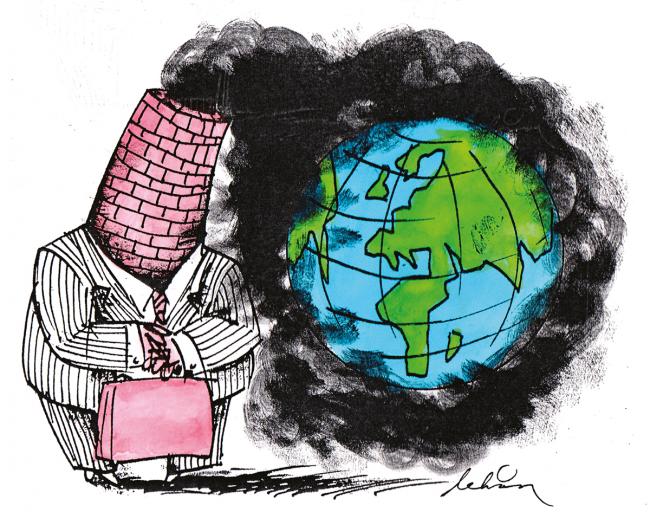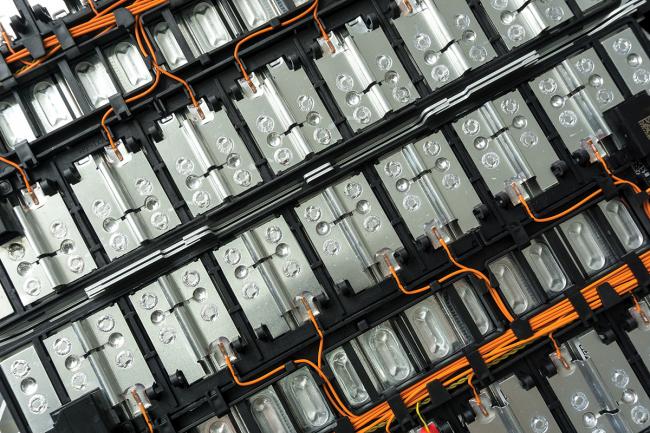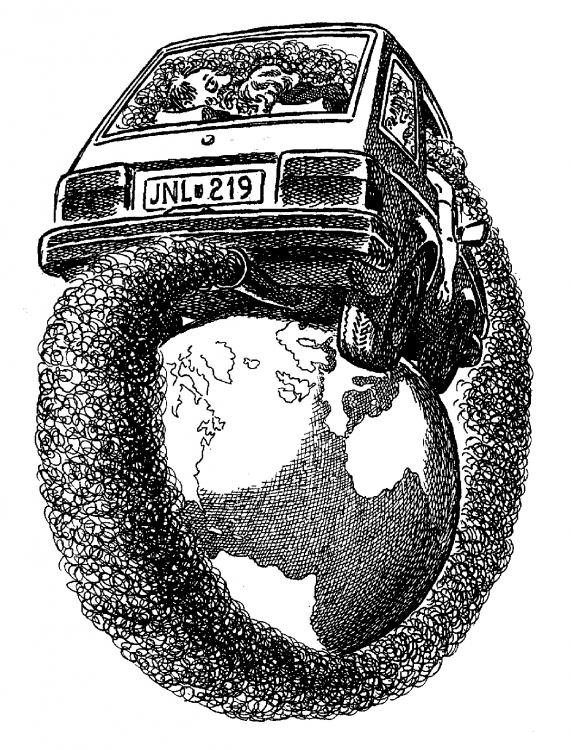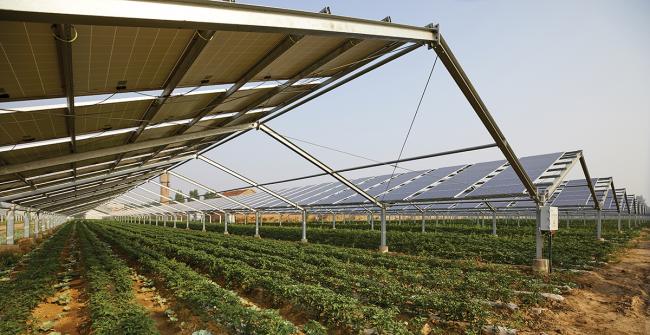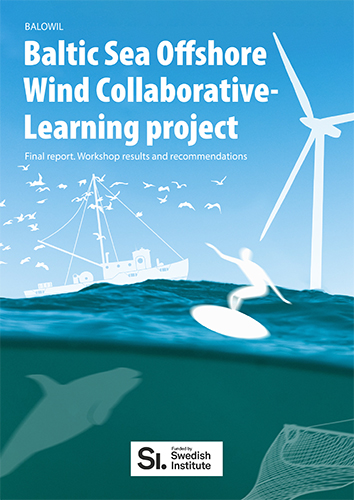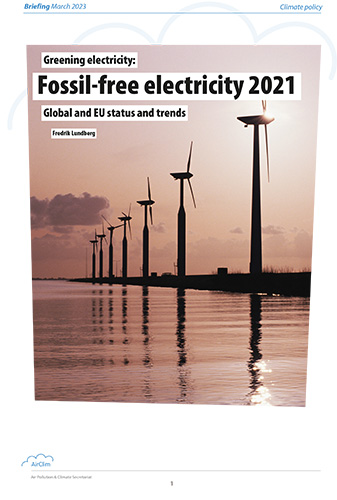

Looking back over 40 years
1980
Four Swedish environmentalist organisations set up a joint project for the international dissemination of information on air pollution and acidification. This leads to the establishment of the Swedish NGO Secretariat on Acid Rain in January 1982, re-named the Air Pollution & Climate Secretariat (AirClim) in 2008.
An eight-year research project in Norway confirms that there had been an increase in the acidity of precipitation and that there is a connection between acidification and reduced fish stocks.
1981
Reports begin to appear in the West German press of a marked increase in damage to forest trees, which could be attributed to air pollution.
A cost-benefit study produced by the OECD shows that the economic gains of halving West European emissions of sulphur over a 10-year period could be worth as much as six times the costs.
1982
At the Stockholm Conference on Acidification of the Environment, scientists state that if acidification of the surface waters in sensitive areas is to be avoided, annual depositions of sulphur should be less than 3–5 kg per hectare. Afterwards, West Germany, which had been strongly opposed to any international action, surprises a meeting of environment ministers by urging that all countries should tackle air pollution at its source.
1983
The first International Acid Rain Week takes place in April, accompanied by a series of awareness-raising activities carried out by environmentalist organisations in several European countries.
Entry into force of the 1979 Convention on Long-Range Transboundary Air Pollution (LRTAP). At the first meeting of the Convention’s Executive Body, Sweden, Norway, and Finland jointly propose that countries should reduce their emissions of SO₂ by at least 30 per cent by 1993. Five other countries – Austria, Canada, Denmark, Switzerland and West Germany – back the proposal.
A proposal for a new EC directive to reduce emissions of SO₂, NOx and dust from large combustion plants – evidently influenced by West German legislation adopted earlier in the year – is put forward by the Commission.
1984
Ten countries, meeting in Ottawa in March, commit to reducing their emissions of SO₂ by at least 30 per cent by 1993. A June meeting of ministers in Munich boosts the membership of this 30-per-cent club to 18.
1985
By signing the first protocol to reduce emissions under the LRTAP Convention, 21 countries commit to reducing their emissions of sulphur dioxide by at least 30 per cent from 1980 to 1993.
Environment ministers of EC countries agree on new emission standards for cars, to be introduced in stages over three years, starting in 1988.
1986
A report published by the Nordic Council in April sets out critical loads for sulphur and nitrogen based on scientific evidence. Basing their claims on the Nordic Council’s report, European environmentalist organisations put forward a call to reduce SO₂ and NOx emissions by at least 90 and 75 per cent respectively, adding that emissions of ammonia and VOCs would also have to be cut considerably.
1988
In a further protocol to the LRTAP Convention, 26 countries agree not to let their emissions of NOx exceed 1987 levels after 1994. The critical load concept is adopted by the Convention, thus making it central to the development of future protocols.
After five years of negotiation, in November the environment ministers of the EC adopt a directive to limit emissions of SO₂, NOx and dust from large combustion plants, known as the LCP directive.
Recognising the problem of potential global climate change, the World Meteorological Organization and the UN Environment Programme establish the Intergovernmental Panel on Climate Change (IPCC). In June, the Toronto Conference on the Changing Atmosphere becomes the first high-level international meeting to recommend targets for reducing greenhouse-gas emissions.
1989
In June, the EC environment ministers decide to set stricter requirements for cars. With effect from 1993 all new petrol-driven cars must be equipped with catalytic converters.
1989–1990
The turmoil occasioned by political change in Central and Eastern Europe leads to a marked fall in industrial output and energy consumption, with a consequent reduction in emissions of air pollutants.
1990
Researchers at Stockholm Environment Institute publish an assessment recommending that the temperature rise should be limited to 0.1°C per decade, and the maximum rise in the mean global temperature above the pre-industrial level should not exceed 1.0 to 2.0°C (low and high risk limits).
Legislation on industrial emissions passed in West Germany in 1983 has resulted in the commissioning of almost 200 desulphurisation plants at power stations with a total generation capacity of 38,000 MW. In addition, power stations with a capacity of more than 30,000 MW have been equipped for selective catalytic reduction (SCR) of NOx emissions.
1991
Twenty-one countries sign the VOC protocol to the LRTAP Convention, most of them with the aim of reducing their emissions by at least 30 per cent between 1988 and 1999.
A strategy to limit emissions of CO₂ and improve energy efficiency is proposed by the European Commission.
1992
The UN Framework Convention on Climate Change (FCCC) is adopted in May. Although it involves no binding commitments, industrialised countries promise to aim to keep CO₂ emissions below their 1990 levels after the year 2000.
1993
In its Fifth Environmental Action Programme, the EC states that the long-term objective for acidification is that critical loads should never be exceeded. Moreover, “all people should be effectively protected against recognized health risks from air pollution,” and WHO values should “become mandatory at EC level” by the year 2000.
1994
The second sulphur protocol to the LRTAP Convention, signed by 26 countries, is the first to use the critical loads approach. Setting separate ceilings for each country’s emissions, it was expected to more than halve overall European emissions of SO₂ by 2010, in relation to 1980 levels.
1995
Austria, Finland and Sweden join the European Union (EU). The EU Council of environment ministers decides to develop an EU-wide acidification strategy with the eventual aim of ensuring zero exceedances of critical loads. The acidification strategy was adopted by the Commission in 1997.
1996
Completion of the first installation for flue-gas desulphurisation (FGD) at a British coal-fired power plant. This cuts emissions from one of Europe’s largest coal-fired plants (Drax, 4000 MWe) by more than 90 per cent, from around 300,000 to between 20,000 and 30,000 tonnes of SO₂ per year.
The European Commission proposes new exhaust and fuel standards for road vehicles largely based on the outcome of several years of collaboration between the Commission, the oil industry and vehicle manufacturers under the Auto-Oil programme. The new standards were adopted by the Council in 1998–99.
1997
Revised air quality guidelines are issued by the World Health Organization (WHO). These guidelines subsequently influence the setting of limit values in EU directives for air quality.
After seven years of debate, the first global standards aimed at reducing air pollutant emissions from ships (Annex VI to the MARPOL Convention) are adopted by the UN International Maritime Organization (IMO).
EU environment ministers agree in March that the aim of global climate negotiations should be to strive to reduce emissions from industrialised countries by 15 per cent between 1990 and 2010.
The Kyoto protocol to the UN FCCC is signed by 160 countries. It is expected to bring about a 5.2-per-cent reduction in industrialised countries’ emissions of greenhouse gases between 1990 and 2008–2012.
1998
The Commission presents a proposal for revision of the 1988 directive on emissions of SO₂, NOx and dust from large combustion plants.
In an agreement with the Commission, the car industry promises that average emissions of CO₂ from new cars sold in the EU will not exceed 140 g/km by 2008/09.
1999
Two new EU directives for air pollution control are adopted. One limits the sulphur content of heavy fuel oil to 1.0 per cent (from 2003) and that of gas oil to 0.1 per cent (from 2008). The other sets new, stricter emission limits – so-called Euro III, IV and V standards – for heavy-duty vehicles, to be introduced in three stages between 2000 and 2008.
The first daughter directive under the 1996 framework directive on ambient air quality is adopted. It covers SO₂, NO₂, particles (PM10) and lead, and sets limit values to be achieved by 2005 or 2010.
In June the Commission puts forward a proposal for a new directive, adapted to its acidification and ozone strategies, setting binding national emission ceilings for four major air pollutants (the NEC directive).
In Gothenburg, 27 countries sign the LRTAP Convention’s Protocol to abate acidification, eutrophication and ground-level ozone (also known as the Gothenburg Protocol), which sets national emission ceilings for 2010 for four air pollutants. This is expected to bring down overall European emissions of SO₂ by 63 per cent, those of NOx and VOCs by 40 per cent, and of NH₃ by 17 per cent, all from 1990 levels.
2000
A proposal for a European climate change programme is presented by the Commission. It suggests setting up a greenhouse gas emissions trading scheme (ETS), starting in 2005.
2001
According to the third assessment report of the IPCC, global temperatures could rise between 1.4 and 5.8°C over the next hundred years.
In its Clean Air For Europe (CAFE) programme, the Commission says that it intends to bring all its efforts to improve air quality under one umbrella. The first major outcome will be a thematic strategy on air pollution to be adopted in 2004.
Towards the end of the year, the directive on national emission ceilings (NEC) and the revised LCP directive (setting stricter emission standards for large combustion plants) are adopted. The NEC directive is expected to cut emissions of SO₂, NOx, VOCs and NH₃ from the 15 EU member states by 76, 51, 60, and 18 per cent respectively, between 1990 and 2010.
At UN FCCC meetings in Bonn and Marrakech, an agreement is finally reached – after four years of negotiating – on how the Kyoto Protocol should be interpreted.
2002
In its Sixth Environmental Action Programme, the EU sets long-term objectives for air quality, acidification and eutrophication, including the stipulation that critical loads and levels should never be exceeded.
An EU strategy on air pollution from seagoing ships is presented by the Commission, including a proposal to regulate the sulphur content of marine fuels.
2003
After conciliation, a new EU directive is adopted that will lower the sulphur content in petrol and diesel for road vehicles to 50 ppm from 2005, and to 10 ppm from 2009.
The world’s biggest experiment in congestion charging begins in London in February and reduces overall traffic levels by 15–20 per cent.
2004
Representing the largest number of countries ever admitted at one time, Cyprus, the Czech Republic, Estonia, Hungary, Latvia, Lithuania, Malta, Poland, Slovakia, and Slovenia accede to the EU on 1 May.
Air pollutants, primarily fine particles (PM2.5), are responsible for the premature death of some 370,000 people every year in the EU25, according to calculations for the EU’s CAFE programme.
2005
The Kyoto Protocol comes into force. The EU Heads of State back calls for a 15–30 per cent reduction in GHG emissions from industrialised countries by 2020. They also endorse the goal of keeping global temperature rise below 2°C above pre-industrial levels.
Late implementation and inadequate plans result in many cities in most EU member states not meeting the air quality standards for PM10 that became mandatory from January this year.
By revising the directive on sulphur in liquid fuels, EU legislation now sets limits on the maximum allowable sulphur content of shipping fuels used in European sea areas.
The 1997 Annex VI to the IMO’s MARPOL Convention comes into force. The IMO’s Marine Environment Protection Committee agrees to revise Annex VI, with the aim of adopting stricter new global emission standards for international shipping before the end of 2007.
The Commission presents its Thematic Strategy on Air Pollution, which sets the level of ambition regarding air quality in the EU until 2020. As part of the strategy, the Commission also proposes a new air quality directive, adding standards for PM2.5.
2006
The WHO reinforces its air quality guidelines for a number of pollutants and makes them global.
In December, new EU passenger cars emission standards for NOx and PM are agreed, with Euro 5 standards to become mandatory from 2009, and Euro 6 standards from 2014.
Allowing greenhouse gas emissions to continue to increase may cost up to 20 per cent of global GDP, according to a report by former World Bank chief economist Nicholas Stern, published on 30 October.
2007
EU Heads of State agree that EU greenhouse gas emissions must be cut by at least 20 per cent between 1990 and 2020. Moreover, 20 per cent of energy used in the EU in 2020 must come from renewable sources.
Evidence that human activities are causing the planet to warm is now “unequivocal”, the IPCC says in its fourth assessment report. To meet the target of 2°C with a reasonable degree of confidence, emissions in 2050 must be 50–85 per cent below the 1990 level.
A new scientific study reveals that emissions from international shipping kill up to 64,000 people a year, including 27,000 in Europe, at a cost to society of more than USD 330 billion per year.
2008
A new EU directive on air quality is adopted, setting the first-ever limits for PM2.5, which must not exceed the annual mean of 25 µg/m3 from 2015. This is significantly weaker than the WHO guideline limit of 10 µg/m3. It also allows EU states to delay implementation of existing limit values for PM10 (from 2005 to 2011) and NO₂ (from 2010 to 2015).
After three years of negotiations, new global limits on emissions of SO₂ and NOx from international shipping are adopted by the IMO. This means that the maximum content of sulphur in marine fuels will come down from the current 4.5 per cent, to 3.5 per cent in 2012 and then down to 0.5 per cent in 2020.
In December, the EU 2020 Climate Package is agreed, with the goal of reducing GHG emissions by at least 20 per cent by 2020, from base year 1990. It also sets goals of a 20-per-cent share of renewables and 20-per-cent energy savings to be achieved by 2020.
2009
Euro VI emission standards for heavy-duty vehicles are adopted. The new emission limits, which also include particle number (PN) limits, become effective from 2013.
A new EU regulation for passenger cars establishes a CO₂ emission target of 130 g/km to be reached by 2015. The regulation also defines a long-term target of 95 g CO₂/km to be reached from 2020.
In the run-up to the UN FCCC’s COP15 in Copenhagen in December, a coalition of island states and least-developed countries jointly call for global GHG emissions to peak by 2015 and be cut by 85 per cent by 2050, from 1990 levels. Moreover, rich countries should reduce emissions by 40 per cent by 2020 and 95 per cent by 2050. Such reductions are needed to keep temperature rise as far below 1.5°C as possible.
While COP15 in Copenhagen managed to gather most world leaders, the outcome was widely seen as a failure, as no timetable for binding new emission reductions was agreed.
2010
A new EU directive to prevent and control emissions from industrial installations is adopted. The industrial emissions directive (IED) incorporates into a single legal text seven older directives, including those on integrated pollution prevention and control (IPPC) and large combustion plants (LPC), and sets stricter emission limits for SO₂, NOx and dust.
The IMO designates waters off North American coasts as an emission control area (ECA), mandating max 0.1 per cent sulphur in marine fuels from 2015 and stricter NOx emission standards for new ships from 2016.
2011
The Commission announces in March that prompt action is required to further reduce air pollution by PM, NO₂ and ground-level ozone, and that an up-to-date clean air strategy is to be adopted in 2013, including a proposal to revise the NEC directive.
Europe should take an integrated approach for management of reactive nitrogen, say scientists in the European Nitrogen Assessment programme. They estimate that the overall health and environmental costs of nitrogen losses amount to €70–320 billion per year.
2012
After five years of negotiations, a revised Gothenburg Protocol to the LRTAP Convention is finalised in May, establishing new binding country-by-country emission reduction targets for five main air pollutants, to be achieved by 2020.
A new EEA assessment of compliance with the NEC directive shows that 12 EU member states exceeded one or more of their emission ceilings for 2010.
The WHO expert group IARC concludes that diesel exhaust can cause lung cancer.
The EU revises its directive on sulphur in marine fuels, primarily to bring EU regulations into line with MARPOL Annex VI on sulphur limits for ships operating in emission control areas (ECA). Moreover, the IMO global 0.5 per cent sulphur limit will become mandatory in EU waters outside ECAs by 2020.
2013
A new global treaty to cut mercury pollution – the Minamata Convention – is agreed, containing a mixture of mandatory and voluntary measures.
The WHO-led project REVIHAAP shows links between PM2.5 and mortality at levels below the current WHO air quality guideline of 10 µg/m3 and recommends a revision of the guidelines by 2015.
In December, the Commission presents its “Clean Air Programme for Europe”. The main legislative proposal is to revise the NEC directive, setting new country-by-country emission reduction requirements for six main air pollutants up to 2030. The monetised health benefits of less air pollution in 2030 are up to 42 times greater than the emission abatement cost.
2014
To keep its international climate pledges, the EU must cut GHG emissions by 40 per cent between 1990 and 2030, says the Commission. Emissions covered by the ETS should fall by 43 per cent, and the share of renewables in the energy mix should be at least 27 per cent by 2030. No binding target for energy efficiency is proposed.
The WHO reports that air pollution (outdoor and indoor) is now the world’s largest single environmental health risk, linked to around 7 million deaths in 2012.
A Dutch study finds that diesel-driven Euro 6 cars emitted around 500 mg NOx/km in real-world driving – more than six times the emission limit of 80 mg/km.
Air pollution from residential heating with solid fuels (wood and coal) causes more than 60,000 premature deaths per year in Europe, according to a study by a LRTAP Convention expert group.
2015
From 1 January, all ships in the Baltic Sea and the North Sea must comply with the ECA limit of max 0.1 per cent sulphur in marine fuels. The same limit also applies in waters within 200 nautical miles of North American coasts.
In September, the US EPA announces that Volkswagen breached federal emissions legislation by fitting illegal software (defeat devices) to cheat emissions tests, resulting in excessive NOx emissions of 10–40 times the US limit. “Dieselgate” is soon found to involve millions of diesel cars in Europe.
In Paris, on 12 December, the UN FCCC adopts a new legally binding international treaty to limit global warming to well below 2°C, preferably to 1.5°C, compared to pre-industrial levels.
2016
The new NEC directive is finally adopted after more than two years of negotiations. It is expected to cut EU emissions of SO₂, NOx, PM2.5, VOCs and NH₃ by 79, 63, 49, 40 and 19 per cent respectively by 2030, compared to 2005, and almost halve the health impacts of air pollution. During the negotiations, member states managed to remove the ozone precursor methane completely from the directive, despite objections from the Parliament and the Commission.
Stricter air pollution standards for machinery are adopted in the revised non-road mobile machinery (NRMM) directive, covering diesel and petrol engines in a wide variety of off-road applications, including bulldozers, trains, chainsaws and larger inland ships.
2017
In a landmark ruling, the EU Court of Justice in April finds Bulgaria to be in breach of the air quality directive, having systematically and continuously exceeded PM10 limit values and having failed to prepare effective air quality plans.
Stricter air pollution emission standards for large combustion plants are set out in a new reference document for best available techniques (BREF) under the industrial emissions directive. The new standards will apply from 2021.
Three-quarters of EU ecosystems are exposed to more nitrogen deposition than they can cope with and nearly one-tenth is still receiving too much acid fallout, according to new data from CLRTAP experts at the Coordination Centre for Effects.
2018
Germany’s highest federal administrative court in February rules that German cities in areas where air pollution exceeds legal limits can introduce diesel restrictions with immediate effect.
In its first Clean Air Outlook, the Commission shows that only a handful of countries will have to take additional measures to meet their 2030 emission targets for SO₂ and NOx, while more effort is required by many countries to achieve the targets for VOCs and PM2.5, and especially for NH₃.
Noting that the Commission has 30 ongoing infringement proceedings on the air quality directive, the European Court of Auditors urges tougher action on air pollution by member states and the Commission. It also proposes to update the directive, including alignment of the standards with the latest WHO guidance.
The IMO finally agrees an initial greenhouse gas strategy for shipping, aiming to reduce emissions by at least 50 per cent by 2050, compared to 2008. Specific short-, medium-, and long-term measures are to follow later.
Responding to the IPCC’s 1.5°C report, published in October, Climate Action Network Europe concludes that the EU must cut domestic GHG emissions by at least 3 per cent per year, and reach near-zero emissions by 2040.
2019
Establishing an emission control area (ECA) in the Mediterranean Sea areas would slash emissions of SO₂, NOx and PM2.5 and bring significant health and environmental benefits, according to two independent expert studies.
New calculations show that air pollution causes nearly 800,000 premature deaths each year in Europe and 8.8 million worldwide, nearly double previous estimates.
The LRTAP Convention celebrates its 40th anniversary in November and decides to start a review of the 2012 Gothenburg Protocol.
In December, the Commission announces the European Green Deal, including plans to come forward with a series of initiatives and legislative proposals relevant to the climate and air pollution, such as a climate law, revision of the ETS, action plans on circular economy and zero pollution, and a farm-to-fork strategy.
2020
Measures introduced to combat the global Covid-19 pandemic result in (temporarily) reduced emissions of air pollutants and GHG. The lockdowns have significantly improved air quality, particularly in big cities.
In its NEC directive implementation report, the Commission says that most member states are at risk of not complying with their 2020 or 2030 emission reduction commitments, and that efforts are especially needed to reduce ammonia emissions from agriculture.
In September, the Commission proposes a new EU target for 2030 to reduce GHG emissions by at least 55 per cent compared to levels in 1990, a target that was later also supported by member states. But the European Parliament wants a target of 60 per cent, and environmental groups say that at least 65 per cent is needed in order to avoid dangerous climate breakdown.
Christer Ågren

 Download this issue
Download this issue